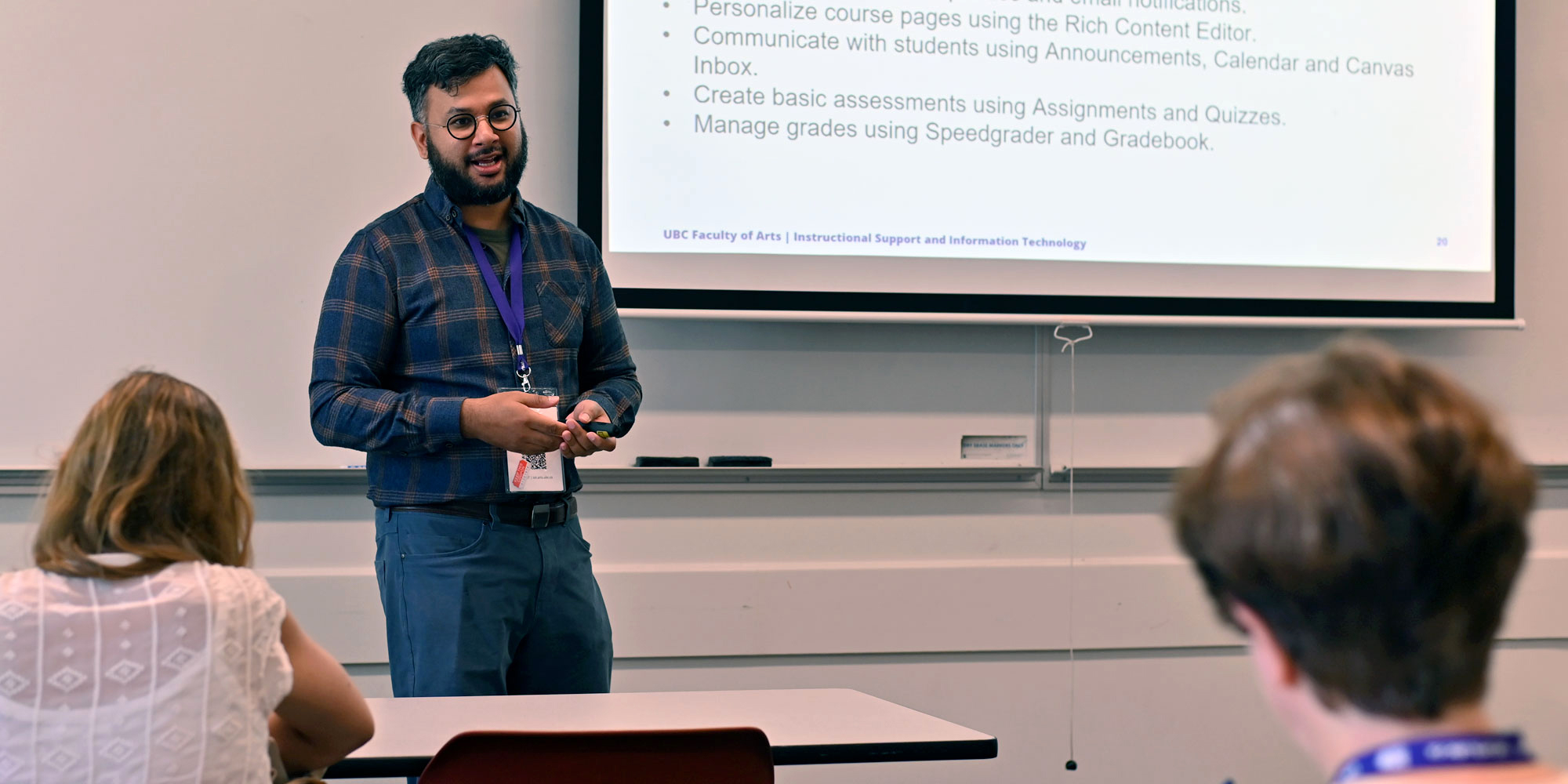

Peer review can be an enriching activity you can use in your classroom.
Explore this guide to learn about the benefits peer review brings to student learning, how to design peer review activities, and what strategies you can incorporate to make it a successful learning activity.
Peer review benefits to student learning
Clarifying assignment goals and criteria
Assessing peers requires students to examine assignment criteria more closely. It gives them practice applying the criteria to multiple examples, giving them a better ability to reflect on how their work matches up against the criteria. Students can have different conceptions about learning goals and criteria from those of instructors (Hounsell, 1997; Norton, 1990). Through peer assessment practice, students will become familiar with assessment criteria and aware of the traits that distinguish successful performance from those that fail to meet the expectation.
More feedback, more quickly
Instructors are often unable to give frequent detailed feedback on multiple writing assignments. Instructor time is cited as one of the major factors limiting increased opportunities for students to practice writing and get feedback on their work (Cho and Schunn, 2007). In addition, receiving diverse feedback from multiple peers offers the chance to learn from different perspectives.
Learning through giving feedback
Students learn by providing constructive feedback as it engages students in complex problem-solving processes of diagnosing problems and suggesting solutions. Studies have shown that providing elaborated feedback that includes descriptions of problems and scaffolded solutions is the element of peer assessment that most benefits student learning (Lie et al. 2010, 2012; Topping et al. 2013).
Increased critical engagement with assignments
Peer assessment increases the time students spend thinking critically about an assignment through “reviewing, summarizing, clarifying, giving feedback, diagnosing misconceived knowledge, identifying missing knowledge and considering deviations from the ideal.” (Topping 1998)
Encourages reflective comparison
When students assess their peers’ work, they actively compare their work to their peers’ with reference to assignment requirements, instructor expectations, and perceptions of quality (Baker 2016; Nicol, Thomson and Breslin 2014). Engaging students as critical readers of their peers’ writing also help them develop a better understanding of how readers might interpret the texts they produce (Cho and Cho 2011; MacArthur 2010).
Active engagement
Peer assessment encourages active learning by engaging students in the feedback process rather than just being passive recipients of feedback from an instructor (Liu and Carless 2006; Cartney 2010; Nicol 2011). They are alerted to the value of feedback instead of seeing it as a justification for a grade. Peer assessment can help to provide opportunities for earlier feedback so that students can use it to improve their work by revising drafts or incorporating what they’ve learned into subsequent assignments. Studies show students are more motivated to engage with and use feedback when the immediate utility of that feedback is clear (Moore and Teather 2013). Opportunities to apply knowledge through practice and receive quality feedback on that practice are known to positively impact student learning (Nicol and Macfarlane-Dick 2006).
Improved understanding of their work
Students develop the metacognitive capacity to think more critically about their work by evaluating their peers’ work. Training and experience in peer assessment may also help correct the adverse effects of students overestimating or underestimating their performance. In addition, it can make students more independent learners, lessening their dependence on instructor feedback (Nicol, Thomson and Breslin 2014).
Increased opportunities for writing in the discipline
Including students in the process of providing feedback and possibly grading the work of their peers can be a way to incorporate more disciplinary-based writing activities without placing too much additional burden on instructor time.
Development of lifelong skills
Peer assessment helps students develop lifelong, transferable skills such as engaging in critical review of the work of peers and colleagues, communicating feedback constructively and positively, learning to accept the feedback of others and incorporating the feedback from multiple people into their work. This helps prepare them to independently engage in these activities after leaving school.
Designing peer review activities
The concept of peer assessment is broad and thus can be implemented in various ways, so it is important to think through some of the basic elements that go into designing a peer assessment activity in light of the desired learning outcomes. (modified from Gielen 2010 and Topping 1998).
Object of assessment
What will students produce? (paper, web page, poster, presentation, video, group project participation/contribution) What skills are students expected to develop and demonstrate as they produce this artifact?
Product of peer assessment
What is the output that students create while assessing their peers? (grades, rubric, ranking, guided questions, qualitative feedback)[H3] Formative or summative
Will the final product be peer assessed for a grade, or will students submit a draft product for peer assessment that they can revise before submitting it to the instructor?
Grading
How will students be graded on the assignment? Will peer assessment replace the instructor assessment (substitutional)? Will students receive marks or feedback from peers and instructors (partially substitutional)? Or will the peer assessment provide additional feedback but be primarily assessed by the instructor for the final grade (supplementary)? Will you give students feedback or assign a grade, with or without evaluation, for their assessments of their peers?
Reviewer organization and directionality
How will peer assessors be assigned? (e.g. randomized, self-selected, instructor-selected, small group, pair-matched). How many assessments will you require each student to complete? Will the reviews be anonymous, or a dialogue between the peers reviewing each other?
Student training
How experienced and confident are the students with peer assessment? How will students be trained to assess the work of their peers and provide feedback? At what point in the process does the training occur?
Frequency and positioning
Will multiple scaffolded activities across a term or a single peer-assessed activity exist? Will the peer assessment provide feedback at multiple stages in a larger assignment or at the end? Will there be a ‘practice peer feedback activity’ to get students familiar and comfortable with this? Are students’ skills and familiarity built up over a series of courses at a curricular level, or is this type of activity unique to your course?
Strategies for success
Set expectations and clarify goals
Students are often apprehensive about peer assessment, particularly when peer grading is involved and giving and receiving feedback. It is important to clarify the expectations and goals of the activity for all involved to build trust at the beginning and get student buy-in. Students could be asked to read one of the educational research studies on peer review cited in this guide.
Provide training for students
It is important to provide training activities to teach students how to assess their peers’ work and provide constructive feedback. This can help not just to increase the ability of students to conduct peer assessments but improve students’ confidence in the process. In large classes, TAs will need to be trained first so they can provide training to students.
Model assessment and feedback
Model the act of assessing and giving feedback to your students by guiding them through assessing some sample assignments. It helps to provide examples of assessed work that show varying performance levels or indicate common challenges you want students to focus on. This can be done through online modules or as in-class activities.
Emphasize written and elaborated feedback
While rating peers’ texts using rubrics and scoring criteria can improve students’ writing skills, studies show that students consistently benefit more from providing written feedback to peers than any other activities that are part of the peer review process (Lu and Law 2012; Wooley et al. 2008).
Novice peer reviewers tend to focus on surface-level feedback and revisions, focusing on grammar or error corrections rather than meaning-level changes. Giving specific instructions, training and guided feedback prompts can help raise the feedback quality and resulting learning benefits. Studies show students benefit most from constructing feedback where they identify strengths and weaknesses and offer suggestions and strategies for improvement. (Patchan and Schun 2015)
Allow opportunities to apply feedback
Feedback is most useful when learners act on it. Design into the series of activities some opportunities for students to make revisions to their work and reflect on how the feedback they received influenced the revisions. It can also be helpful to have students reflect on the feedback and revision process. Why did they accept or reject suggestions? How did they modify their work after receiving feedback? How did evaluating their peers’ work change how they saw their work?
Allow adequate time and spacing for the process
In order to encourage a deeper level of engagement, begin the peer assessment process early in the term so that there is adequate time for students to reflect on the feedback they receive and apply it to their learning either through revision or on subsequent assignments. Studies have shown that revisions early in the process focused on substantial, content-based changes, while revisions close due date resulted in polishing edits focused on grammar, word substitution, and spelling (Baker 2016; Cho and MacArthur, 2010). In a 12-week class schedule, the ideal design will start the peer review activities by week three.
Align peer assessment to key learning goals
Make sure the peer assessment activities are aligned with core learning goals so that it is clear to students how the activities benefit their learning and are not perceived as an add-on assignment with little value. Peer assessment activities take considerable time and effort from students, but positioned strategically can help focus student effort and deepen critical engagement around key learning goals. If grades are assigned for giving feedback, they must be weighted heavily enough to indicate the importance of this activity.
Challenges in peer review
Setup and monitoring time
Instructors often adopt peer assessment to integrate writing activities into their classes without adding too much extra time commitment. While peer assessment has shown positive learning benefits for students, there might not be time-saving for the instructor in the short or medium term since a considerable amount of effort is needed to design, implement, and monitor high-quality activities (Topping 1998). In the long term, there may be time benefits after the assignment has been designed and implemented.
Student acceptance
Even though many studies have shown peer-assessed quantitative scoring to be reliable and valid when compared with instructor-given grades, students may not accept peer assessment results as accurate or fair and are apprehensive about peers’ scores being used for grading (Carvalho 2013, K. Cho, Schunn, & Wilson, 2006, Topping 1998).
Student inexperience
Novice students lack a high-level understanding of subject matter issues and experience providing constructive feedback, which challenges peer assessment (Cho and Schunn 2007). These challenges need to be mitigated through scaffolding and training. Instructors must be realistic about the ceiling on students’ ability to provide deep feedback.
Moving beyond surface-level engagement
Students new to critically reviewing their peers’ work may focus on providing positive comments or making surface-level corrections rather than providing meaningful, high-level feedback. Modelling effective feedback is important. Inexperienced student writers may also view revisions as “cleaning up” and linearly revising their texts based on the feedback they receive rather than looking at their argument’s overall meaning and structure of their argument (Patchan and Schunn 2015).


